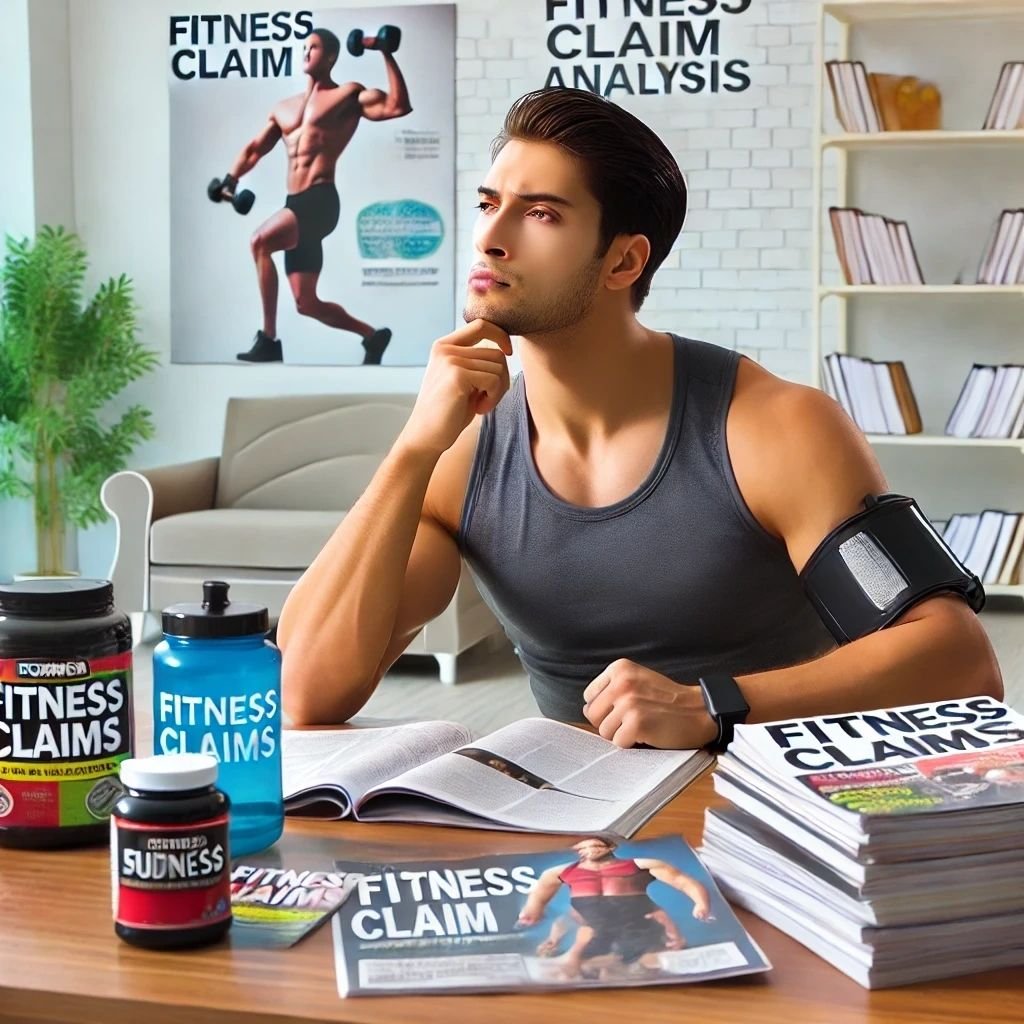The fitness industry is filled with claims, hacks, and “guaranteed results” that you see everywhere, from your local gym to social media influencers. But how do you know which advice to follow and what is pure examples of bro science? If you’ve ever found yourself questioning the advice on muscle building or fat loss, you’re not alone. These so-called truths are often just fitness industry lies, crafted to sell products and push trends.
In this article, we’ll break down the most common fitness myths and arm you with the tools to recognise bro science. By the end, you’ll be able to avoid misinformation, make better fitness choices, and focus on real, science-backed progress.
FAQs About Bro Science and Fitness Industry Lies
1. What is bro science?
Bro science refers to fitness advice based on opinions, hearsay, or trends rather than scientific evidence. It’s often found in gym culture and social media, with claims like “You need six meals a day to boost your metabolism” or “Cardio kills muscle growth.”
2. How can I spot examples of bro science?
Watch out for these red flags:
- Quick-fix promises like rapid muscle gain or fat loss.
- Product-driven advice, often linked to supplements or gadgets.
- Lack of scientific references, relying instead on testimonials or personal stories.
3. Why do fitness industry lies exist?
The fitness industry generates billions by selling supplements, programmes, and gadgets. Many lies are designed to push products that don’t work, preying on your desire for quick results.
4. Are supplements necessary for progress?
Not always. While protein and creatine have proven benefits, most supplements like fat burners or detox teas are ineffective. A balanced diet and proper training are far more impactful for muscle growth and fat loss.
5. How do I verify fitness advice?
- Check the source: Peer-reviewed journals like the Journal of Strength and Conditioning Research provide reliable data.
- Follow expert consensus: Look for guidance from reputable organisations like the NSCA or British Dietetic Association.
- Question motives: If advice is linked to a product sale, stay sceptical.
6. What’s the truth about muscle-building contraptions?
Gadgets like ab belts and EMS devices promise quick results but lack evidence for effectiveness. Real progress comes from resistance training and consistent effort—not shortcuts.
7. How can I avoid falling for fitness industry lies?
- Think critically: Avoid anecdotal evidence and seek science-backed claims.
- Be realistic: Understand that significant results take time.
- Stay consistent: Follow sustainable habits like progressive overload and balanced nutrition.
8. What should I focus on instead of bro science?
- Progressive overload: Gradually increase training intensity.
- Compound movements: Focus on exercises like squats, deadlifts, and pull-ups.
- Consistency: Sustainable habits deliver long-term results, not quick fixes.
My Journey: Learning to See Through Fitness Lies

Twenty-five years ago, I eagerly stepped into the gym, determined to build muscle and get fit. Bro science and fitness industry lies bombarded me from magazines, TV shows, and fellow gym-goers who claimed to know what worked.
I remember obsessively chugging protein shakes, overtraining every muscle group, and wondering why the promised results never came. You want to see examples of bro science? Step back into the 1990’s…. not that things are much better these days.
Over the years, I realised that much of what I believed was based on outdated myths designed to sell supplements or workout programmes.
Through extensive research, study, and hands-on experience, I learned to separate the science from the hype. Now, my mission is to help others avoid wasting time and money on fitness advice that doesn’t work. This article is an expansion on my main pillar article myths about muscle building: the ultimate truth.
What is Bro Science?
Bro science refers to fitness advice that may sound good in theory but crumbles when subjected to scientific scrutiny. It’s the kind of advice you hear from people who look the part but don’t fully understand exercise physiology. Bro science thrives in gym culture and social media, where opinions and hearsay are often mistaken for fact.
Here are some examples of bro science:
- “You need to eat six small meals a day to keep your metabolism up.”
- “Cardio will make you lose muscle.”
- “Protein powders are essential for muscle growth.”
- You need to confuse the muscles with 20 exercises to catapult new growth!
These claims don’t hold up under scientific examination, yet they continue to be popular because they sell. I remember obsessively chugging protein shakes, overtraining every muscle group, and wondering why the promised results never came.
Famous Study: Minnesota Starvation Experiment (1944–1945)
One of the landmark studies that debunked several metabolism myths is the Minnesota Starvation Experiment.
This study showed that the body doesn’t enter “starvation mode” when calories are reduced in a controlled manner. Instead, the metabolic slowdown only becomes significant during extreme deficits, far beyond what most people experience during typical diets. This study highlights the flawed logic behind many bro science claims, such as the need for constant eating to prevent muscle loss.
Spotting Red Flags in Fitness Advice
When it comes to fitness advice, spotting red flags can save you time, money, and a whole lot of frustration. Bro science thrives on making promises that seem too good to be true because that’s exactly how they capture people’s attention. But knowing what to look for can help you avoid falling into the trap of these fitness industry lies.

Common Red Flags and Examples of Bro Science
- Quick-Fix Promises: If someone claims you can gain 10 pounds of muscle in a month or lose 10 pounds of fat in a week and look like your favourite Hollywood star – that’s a major red flag. Fitness takes time, and extreme promises almost always lead to disappointment. Quick transformations, like those promoted by supplement companies, often hide the real secret—extreme diets or PEDs.
- Product-Driven Advice: Be cautious if advice comes with a product pitch. Companies and influencers often package bro science around products like supplements, meal plans, or equipment. These products are usually unnecessary, and their effectiveness is often exaggerated. Always ask yourself: Who benefits from this claim?
- No Scientific References: If a claim isn’t backed by research or scientific evidence, it’s likely bro science. Real fitness advice is rooted in peer-reviewed studies and years of research. Be especially wary of advice that relies solely on testimonials or personal experiences, as these are often cherry-picked to push a specific agenda.
Famous Study: The Framingham Heart Study (1948–Present)
The Framingham Heart Study is one of the longest-running studies in medical history and has provided crucial insights into the impact of exercise on cardiovascular health.
One of its key findings was that regular, moderate-intensity exercise, such as walking or cycling, is just as beneficial for long-term health as high-intensity workouts.
This study debunks the bro science claim that “no pain, no gain” is the only path to fitness, showing that sustainable, moderate exercise can be just as effective, especially over time.
Bodybuilding fact-checking often involves looking at what the heavy hitters in the strength and conditioning world are saying. Organisations like the National Strength and Conditioning Association (NSCA) and the European College of Sport Science (ECSS) usually have well-researched positions on popular training topics.
But here’s the kicker – don’t just rely on one organisation. Cross-reference multiple reputable sources to get a comprehensive view of strength training truths. If there’s a consensus among these bodies, you’re likely on solid ground. If not, well, that’s where it gets interesting!
Source Scrutiny: How to Verify Fitness Claims
In today’s world of social media influencers and viral fitness trends, learning how to verify the information you come across is more important than ever. Misinformation spreads like wildfire, and it can be difficult to separate fact from fiction.
Best Practices for Verifying Sources
- Check the Study: Was the research published in a peer-reviewed journal? Reputable publications like the British Journal of Sports Medicine or the Journal of Strength and Conditioning Research provide trustworthy data. Low-quality or unpublished studies often have small sample sizes or biased funding sources, which is why bro science tends to avoid real scientific scrutiny.
- Evaluate Conflicts of Interest: Always question the motive behind the advice. If someone stands to profit from promoting a particular supplement or product, there’s a conflict of interest. For example, many fitness industry lies are spread by influencers who are paid to endorse products that have no scientific backing. If the advice comes with a link to buy a supplement, be wary.
- Follow the Consensus: Science is built on consensus, not individual opinions. Reliable fitness advice should align with the recommendations of reputable organisations like the British Dietetic Association (BDA), National Strength and Conditioning Association (NSCA), and International Society of Sports Nutrition (ISSN). If a claim contradicts the advice of these bodies, it’s probably bro science.
Famous Study: The Harvard Alumni Health Study (1962–Present)
The Harvard Alumni Health Study provided significant insights into the long-term benefits of regular, moderate physical activity. It showed that consistent exercise, even without extreme intensity, reduced mortality rates and improved overall health.
This directly debunks the myth that only high-intensity workouts lead to meaningful results, showing that long-term fitness is about consistency, not extremity.
The Role of Scientific Consensus in Fitness
Scientific consensus is one of the strongest indicators of reliable information. When multiple studies, conducted over years or even decades, come to the same conclusion, that’s when you know you’re on solid ground.
On the other hand, bro science typically relies on isolated studies or anecdotal evidence, which is why it can seem convincing at first glance but ultimately falls apart when scrutinised.
Key Organisations for Fitness Science
Several key organisations set the standard for fitness advice and consistently debunk examples of bro science:
- National Strength and Conditioning Association (NSCA): One of the most respected authorities on strength and conditioning. The NSCA provides evidence-based recommendations for athletes, trainers, and fitness enthusiasts alike.
- British Dietetic Association (BDA): As the UK’s professional association for dietitians, the BDA is a key player in promoting scientifically grounded nutrition advice. Their guidance debunks many of the diet-related fitness industry lies, including extreme low-carb or detox diets.
- International Society of Sports Nutrition (ISSN): The ISSN publishes extensively on sports nutrition and has clear positions on key supplements like protein, creatine, and BCAAs. Their research helps clear up much of the misinformation in the supplement industry.
Famous Study: The DASH Diet Study (1997)
This well-known study on dietary approaches to stop hypertension (DASH) showed that whole-food-based diets rich in vegetables, fruits, and lean proteins can significantly lower blood pressure. It also debunked many bro science myths about the necessity of extreme low-carb or fad diets for health. Instead, the study promotes balanced eating as the key to long-term well-being.

Follow the Money: Identifying Conflicts of Interest in the Fitness Industry
The fitness industry generates billions of pounds each year, and wherever there’s money, there are people willing to bend the truth to make more of it. That’s why one of the most reliable ways to spot a fitness industry lie is to follow the money. If a fitness guru or influencer stands to make a profit from pushing a certain supplement, programme, or gadget, you should be sceptical.
The Supplement Scandal
The supplement industry is notorious for selling products with exaggerated or entirely false claims. Fat burners, testosterone boosters, and detox teas are some of the most popular offenders, yet research consistently shows they provide little to no benefit for most people.
Despite this, they are marketed as must-have solutions, and fitness influencers are often paid to promote them to their followers.
“The majority of supplements are useless. They make a lot of promises, but the science simply doesn’t support them,” says Dr. Alan Aragon, a respected nutrition researcher.
Supplements with evidence behind them, like protein powders and creatine, still get overhyped. For example, marketers push protein powders as essential for muscle growth, but most people can meet their protein needs with a balanced diet.
Creatine, while one of the most researched supplements, is not the magic solution that many advertisements claim it to be. It’s beneficial, but like any tool, it requires consistent use alongside proper training and nutrition to see results.
Fitness Industry Scandals
Perhaps the most infamous recent scandal in the fitness world is the case of the Liver King (chief amongst the examples of bro science, he’s worth watching for entertainment only), an influencer who built a massive following by promoting an ancestral diet and lifestyle while secretly using anabolic steroids. His story is a cautionary tale of how influencers use their physiques to sell unrealistic results.
But the Liver King is far from the only example. Many fitness influencers push supplements and programmes while using performance-enhancing drugs (PEDs) like steroids or human growth hormone (HGH) to achieve their physiques. These influencers often claim to be “natural” but secretly use drugs to maintain their image, leaving their followers chasing unattainable goals. This deception is one of the worst forms of fitness industry lies.
The Influencer Epidemic: Sellouts and Secret Hormone Use
With the rise of social media platforms like Instagram and YouTube, fitness influencers have gained massive followings and the power to shape the way people approach fitness. However, many of these influencers are promoting products and advice while secretly using PEDs, creating a dangerous cycle of misinformation.

How to Spot a Fraudulent Influencer – Walking Examples of Bro Science
- Unrealistic Results: If an influencer shows extreme transformations in a short period, be cautious. Rapid muscle growth or fat loss often indicates the use of PEDs rather than the programme they’re promoting.
- Product Promotions: If an influencer is constantly promoting supplements, especially those tied to quick fixes or fat loss, they may be more interested in making money than providing good advice.
- No Transparency: Real experts are upfront about what it takes to achieve results. They won’t claim that a single product or workout plan is the key to success. Influencers making these kinds of claims often hide PED use or the real difficulty of achieving their physique.
“Steroids and PEDs are far more common in the fitness world than most people realise,” says Dr. Harrison Pope, a researcher who studies the prevalence of PEDs in sports and bodybuilding. “Many influencers who appear to be natural athletes are using substances that give them an unfair advantage.”
Muscle-Building Contraptions, Supplements, and Scandals: Debunking the Big Lies
Let’s take a deeper look at some of the most popular scams in the fitness world. From muscle-building contraptions to worthless supplements, the fitness industry has sold it all.
Muscle-Building Contraptions
The Shake Weight, EMS (Electrical Muscle Stimulation) devices, and Ab Belts are classic examples of muscle-building contraptions that promise massive gains with minimal effort. These gadgets prey on people’s desire for shortcuts, but the truth is they’re all style and no substance.
While EMS is used in medical and rehabilitation settings to treat injuries, there’s no evidence to support the claim that these devices can replace actual resistance training.
The same goes for the Ab Belt, which promises six-pack abs with no effort. The reality is that visible abs come from a combination of fat loss and core-strengthening exercises, not from wearing a belt that zaps your stomach muscles.
Supplements and Scams
The supplement industry churns out new products every year, many of which offer little more than placebo effects. Fat burners are a perfect example. Despite being marketed as a magic solution for fat loss, scientific studies show that they have no significant impact on metabolism or fat burning.
“Supplements like fat burners are a waste of money. The real key to fat loss is a proper diet and consistent exercise,” says Dr. Brad Schoenfeld, a leading expert in muscle hypertrophy.
Even BCAAs (Branched-Chain Amino Acids), which are sold as a recovery aid, have been shown to be unnecessary for anyone who already consumes enough protein. Protein-rich foods like chicken, eggs, and tofu already provide all the amino acids your body needs for recovery, making BCAA supplements redundant for most people.
Critical Thinking in Fitness: Building Your Mental Muscle

So how do you avoid falling for bro science and fitness industry lies? By building your mental muscle and learning to apply critical thinking to the advice you hear. Just because something is popular doesn’t mean it’s true. You need to ask the right questions, look for the evidence, and trust your scepticism.
Examples of Bro Science – logical Fallacies
- Anecdotal Evidence: One of the most common fallacies in bro science is anecdotal evidence. Just because something worked for someone doesn’t mean it’s effective or backed by science. Fitness advice needs to be based on research, not personal stories.
- Appeal to Authority: Another common tactic is the appeal to authority. Just because someone has a great physique doesn’t mean their advice is scientifically sound. True expertise comes from education and research, not just personal results.
- Post Hoc Fallacy: This fallacy involves thinking that because one thing follows another, it must have caused it. In fitness, this often manifests as someone claiming a supplement or workout “caused” their gains, when in reality, their progress was likely due to a combination of factors like consistent training and proper nutrition.
How to Recognise Quality Fitness Advice
High-quality fitness advice shares a few key traits that can help you identify it as legitimate. Use this checklist before you follow any fitness advice to ensure it’s based on science, not bro science.
Criteria for Legitimate Fitness Advice
- Scientific References: Does the advice cite peer-reviewed studies from journals like the British Journal of Sports Medicine or the Journal of Strength and Conditioning Research? If not, it’s likely bro science.
- Expert Endorsements: Is the advice backed by experts with real qualifications? Look for certifications from organisations like the British Dietetic Association or the NSCA.
- Realistic Claims: Be wary of advice that promises extreme results in a short time. Sustainable progress takes time, and any advice that offers shortcuts is probably based on fitness industry lies.
Real Science and Sustainable Gains: The Path to Real Progress

The truth is, real fitness progress comes from sustainable habits and science-backed methods. While bro science and fitness industry lies promise fast results, they rarely deliver anything meaningful. By focusing on tried-and-true principles like progressive overload, compound movements, and balanced nutrition, you’ll see lasting results.
Famous Study: The Norwegian Frequency Project (2012)
This study examined the effects of training frequency on muscle growth and found that participants who trained each muscle group more frequently (4–6 times per week) made greater gains than those who trained less often. This debunks the bro science myth that working out every day is necessary for progress and shows that balancing volume and frequency is more effective than extreme, high-volume training.
Key Takeaways
- Bro science may sound convincing but often falls apart when examined with real science. Always question advice that seems too good to be true or isn’t backed by research.
- The supplement industry is filled with exaggerated claims. Products like fat burners, testosterone boosters, and detox teas are largely ineffective and waste your money.
- Many fitness influencers promote fitness industry lies while secretly using performance-enhancing drugs, making their results unrealistic for the average person.
- Real fitness progress comes from sustainable, science-backed habits—there are no shortcuts.
- Look for advice supported by reputable studies, expert endorsements, and realistic claims to ensure you’re following legitimate fitness guidance.
Bonus – What Can you realistically Look Like?
Genetics has a lot to answer for. They dictate so much. This doesn’t mean that you’ll never achieve an amazing body, but you need to understand realistic vs lies. Check out my How to get the swimmers body male: 8 uncomfortable fitness truths for further reading.
Conclusion
Navigating the world of fitness advice can be a minefield, but with the right approach, you can avoid the traps of bro science and fitness industry lies. The key is to stay sceptical, question the motives behind the advice, and demand evidence before you take anything at face value.
“Apply the knowledge you’ve gained here to make informed decisions and focus on long-term, sustainable fitness goals.” Remember, real progress doesn’t come from shortcuts—it comes from consistency, effort, and science-backed methods. Keep asking questions, keep learning, and most importantly, keep moving forward.
the next time you’re given some real examples of bro science, send them this articles way….
Chat soon,
Matt


3 thoughts on “How to Spot Examples of Bro Science and Tackle Fitness Industry Lies”
Comments are closed.